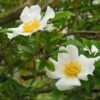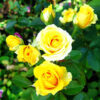Habitat and Ideal Growing Conditions for Rosa laevigata

Rosa laevigata, known for its resilience and beauty, thrives in specific environmental conditions that support its growth and blooming. This section explores the natural habitat of Rosa laevigata and the optimal growing conditions necessary for cultivating this exquisite species.
#### Natural Habitat of Rosa laevigata
Rosa laevigata is native to Southeast Asia, particularly found in regions such as China and Vietnam. In its natural habitat, the plant typically grows along forest margins, riverbanks, and hillsides where it receives adequate sunlight and moisture. The species is well-adapted to both subtropical and tropical climates, characterized by warm temperatures and moderate to high humidity levels.
**1. Climate:**
– Rosa laevigata thrives in regions with a warm, humid climate. It prefers temperatures ranging from 20°C to 30°C (68°F to 86°F) during the growing season.
– The plant can tolerate occasional frost but does best in frost-free climates. In areas with colder winters, it may require protection or be grown in containers that can be brought indoors during freezing temperatures.
**2. Sunlight:**
– Full sunlight is essential for the healthy growth and abundant blooming of Rosa laevigata. It typically requires at least 6 to 8 hours of direct sunlight daily to flourish.
– In its natural habitat, the plant often climbs trees or structures to reach sunlight, showcasing its climbing habit and adaptability to different light conditions.
**3. Soil Requirements:**
– Rosa laevigata prefers well-drained, fertile soils that are slightly acidic to neutral (pH 5.5 to 7.0). Sandy loam or loamy soils enriched with organic matter are ideal.
– Good drainage is crucial to prevent waterlogging, which can lead to root rot and other diseases. Raised beds or mounds can be beneficial in poorly drained soils.
**4. Watering Needs:**
– While Rosa laevigata can tolerate drought conditions once established, regular watering is essential, especially during dry periods. The plant benefits from deep, thorough watering rather than frequent shallow watering.
– Mulching around the base of the plant helps retain soil moisture and regulate temperature, promoting overall plant health.
#### Ideal Growing Conditions for Cultivation
For gardeners and enthusiasts looking to cultivate Rosa laevigata outside its native range, creating an environment that mimics its natural habitat is key to success. Here are the ideal growing conditions recommended for cultivating this species:
**1. Location:**
– Choose a planting site that receives full sunlight for most of the day. South-facing or west-facing locations are generally ideal for maximizing sunlight exposure.
– Ensure there is adequate space for the plant to climb and spread, as Rosa laevigata can grow vigorously under favorable conditions.
**2. Soil Preparation:**
– Prepare the planting area by amending the soil with organic matter such as compost or well-rotted manure. This improves soil structure, fertility, and moisture retention.
– Conduct a soil test to determine pH levels and make adjustments as necessary to ensure the soil is within the preferred range for Rosa laevigata.
**3. Planting Technique:**
– Plant Rosa laevigata during the early spring or fall when temperatures are mild and conducive to root establishment.
– Dig a hole that is slightly larger than the plant’s root ball and position the plant so that the graft union (if applicable) is slightly above the soil level. Backfill with soil and water thoroughly to settle the roots.
**4. Watering and Maintenance:**
– Water newly planted Rosa laevigata regularly to keep the soil evenly moist but not waterlogged. Once established, reduce watering frequency but continue to monitor soil moisture levels, especially during hot, dry periods.
– Apply a balanced fertilizer formulated for roses in early spring to promote healthy growth and flowering. Follow manufacturer’s instructions regarding application rates.
**5. Pruning and Training:**
– Prune Rosa laevigata annually during late winter or early spring to remove dead or diseased wood and encourage new growth and flowering.
– Train the plant to climb structures such as trellises or pergolas to showcase its natural climbing habit and maximize blooming potential.
#### Cultivation Tips for Success
To ensure the optimal growth and flowering of Rosa laevigata, consider the following cultivation tips:
– **Pest and Disease Management:** Monitor the plant regularly for pests such as aphids or powdery mildew. Use organic methods or approved pesticides to manage infestations if necessary.
– **Support Structures:** Provide sturdy support structures for the plant to climb, ensuring it has ample space to spread and bloom freely.
– **Mulching:** Apply a layer of mulch around the base of the plant to suppress weeds, conserve soil moisture, and regulate soil temperature.
By creating a favorable environment that mirrors its natural habitat, gardeners can enjoy the beauty and resilience of Rosa laevigata in their own landscapes. Whether grown for its historical significance, ornamental value, or ecological benefits, this species continues to captivate enthusiasts around the world with its elegant blooms and vigorous growth habits.
### Conclusion
Understanding the habitat requirements and ideal growing conditions for Rosa laevigata is essential for successfully cultivating this remarkable species. By providing adequate sunlight, well-drained soil, and appropriate moisture levels, gardeners can encourage healthy growth and abundant blooming throughout the growing season. Whether planted in gardens, parks, or natural landscapes, Rosa laevigata enriches its surroundings with its beauty and cultural significance, perpetuating its legacy for generations to come.

